ERP Analysis and Implementation Report for CLR Company: Solutions
VerifiedAdded on 2021/09/17
|22
|4429
|41
Report
AI Summary
This report provides a comprehensive analysis of Enterprise Resource Planning (ERP) implementation within CLNRecycle Ltd (CLR), an Australian-based manufacturing and recycling company. It begins with an overview of CLR's background, including its business requirements, such as revenue and market share, product features, supply chain management, and cost reduction. The report then delves into the current operational situation, followed by a detailed software selection process, advocating for SAP S/4 HANA and SAP ECC6 as potential solutions. It also explores the big bang approach for ERP implementation. A risk management process is initiated, and change management strategies are discussed. The report includes an investigation of new solutions provided by Concur Technologies and Callidus Cloud. The Waterfall model for implementation is provided, from discovery and planning, to design, implementation and testing. The report concludes with recommendations for mitigating identified issues and fostering CLR's development in the market.

Running head: ERP Analysis and Implementation
ERP Analysis and Implementation
Name of the Student
Name of the University
Author’s Note
ERP Analysis and Implementation
Name of the Student
Name of the University
Author’s Note
Paraphrase This Document
Need a fresh take? Get an instant paraphrase of this document with our AI Paraphraser
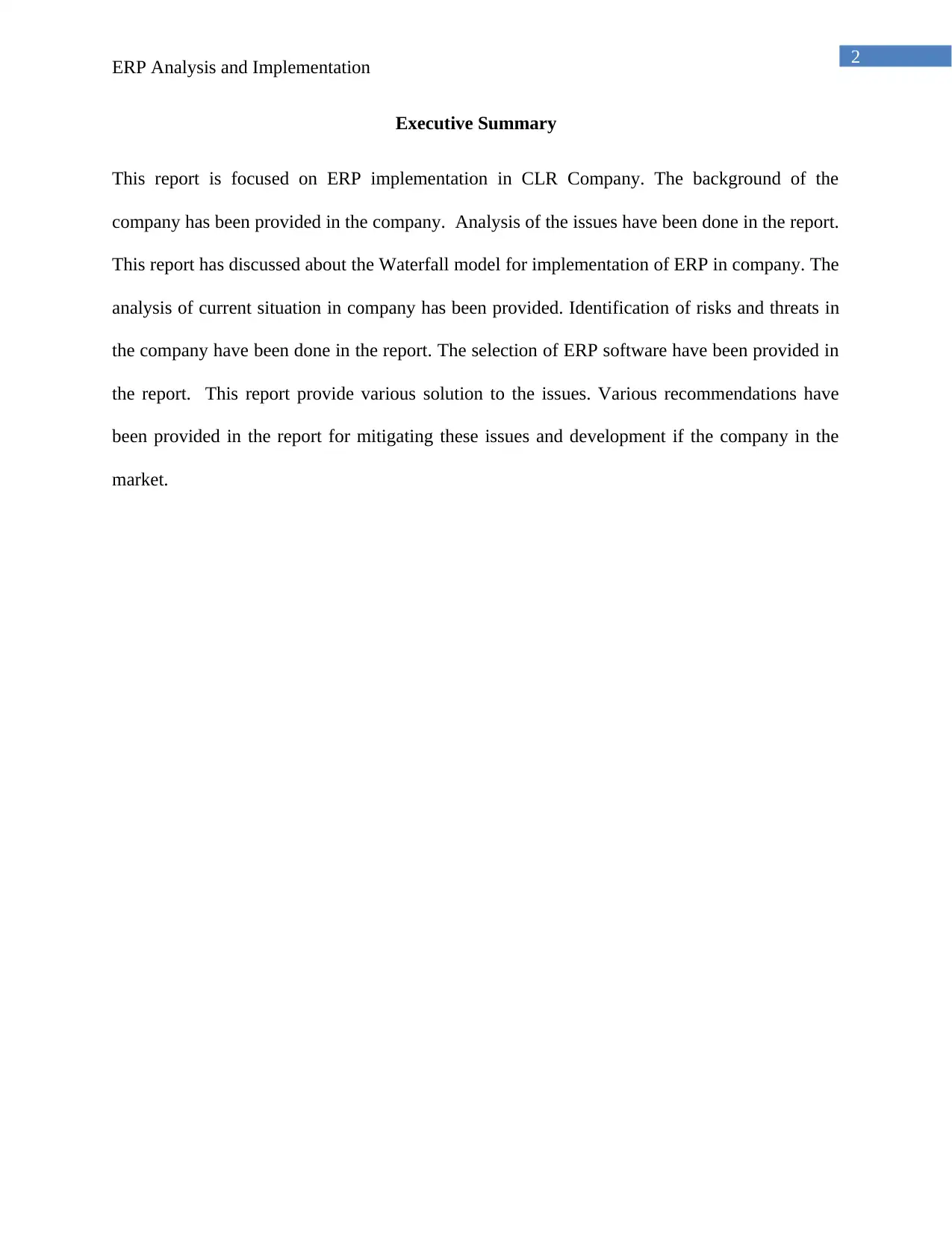
2
ERP Analysis and Implementation
Executive Summary
This report is focused on ERP implementation in CLR Company. The background of the
company has been provided in the company. Analysis of the issues have been done in the report.
This report has discussed about the Waterfall model for implementation of ERP in company. The
analysis of current situation in company has been provided. Identification of risks and threats in
the company have been done in the report. The selection of ERP software have been provided in
the report. This report provide various solution to the issues. Various recommendations have
been provided in the report for mitigating these issues and development if the company in the
market.
ERP Analysis and Implementation
Executive Summary
This report is focused on ERP implementation in CLR Company. The background of the
company has been provided in the company. Analysis of the issues have been done in the report.
This report has discussed about the Waterfall model for implementation of ERP in company. The
analysis of current situation in company has been provided. Identification of risks and threats in
the company have been done in the report. The selection of ERP software have been provided in
the report. This report provide various solution to the issues. Various recommendations have
been provided in the report for mitigating these issues and development if the company in the
market.
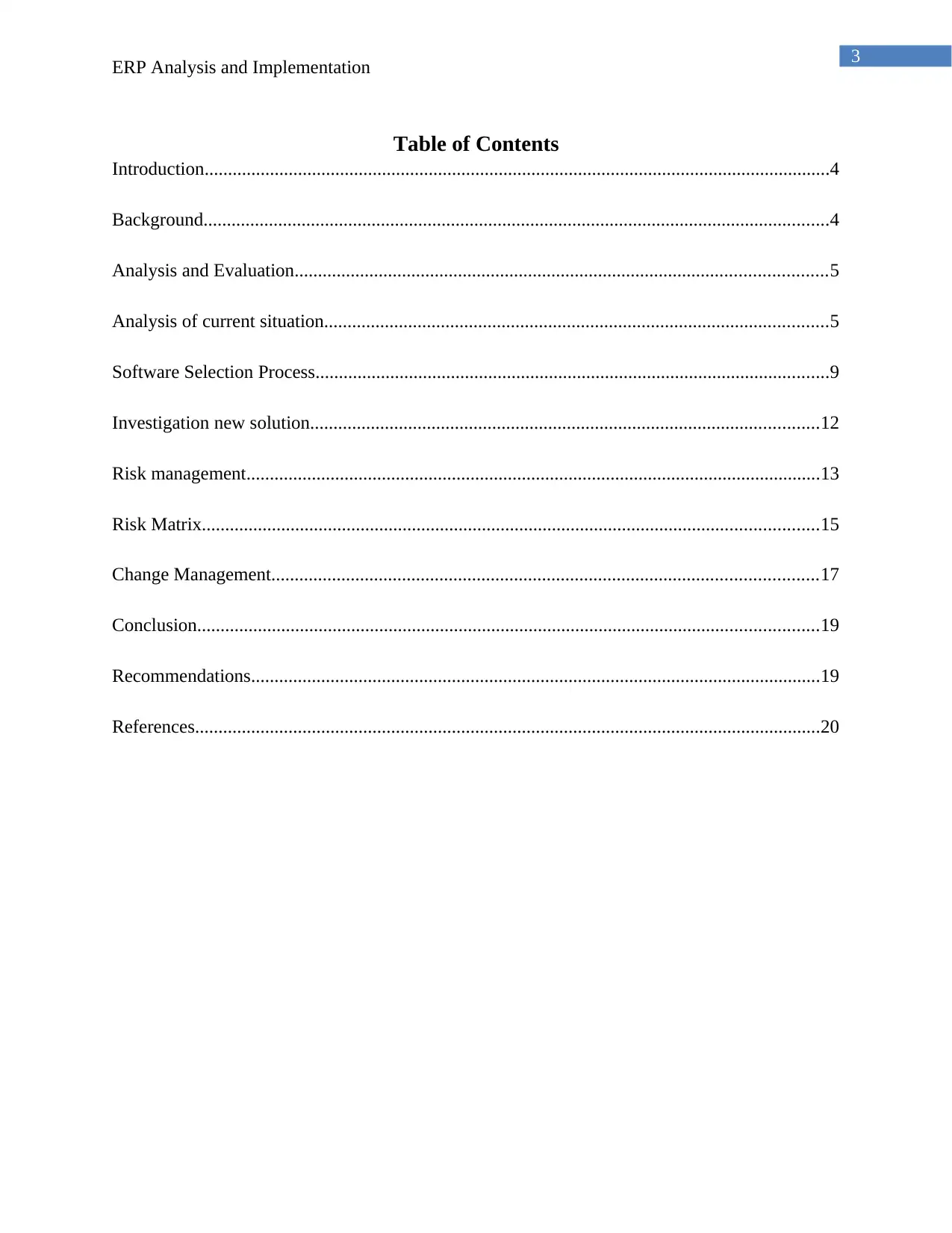
3
ERP Analysis and Implementation
Table of Contents
Introduction......................................................................................................................................4
Background......................................................................................................................................4
Analysis and Evaluation..................................................................................................................5
Analysis of current situation............................................................................................................5
Software Selection Process..............................................................................................................9
Investigation new solution.............................................................................................................12
Risk management...........................................................................................................................13
Risk Matrix....................................................................................................................................15
Change Management.....................................................................................................................17
Conclusion.....................................................................................................................................19
Recommendations..........................................................................................................................19
References......................................................................................................................................20
ERP Analysis and Implementation
Table of Contents
Introduction......................................................................................................................................4
Background......................................................................................................................................4
Analysis and Evaluation..................................................................................................................5
Analysis of current situation............................................................................................................5
Software Selection Process..............................................................................................................9
Investigation new solution.............................................................................................................12
Risk management...........................................................................................................................13
Risk Matrix....................................................................................................................................15
Change Management.....................................................................................................................17
Conclusion.....................................................................................................................................19
Recommendations..........................................................................................................................19
References......................................................................................................................................20
⊘ This is a preview!⊘
Do you want full access?
Subscribe today to unlock all pages.

Trusted by 1+ million students worldwide
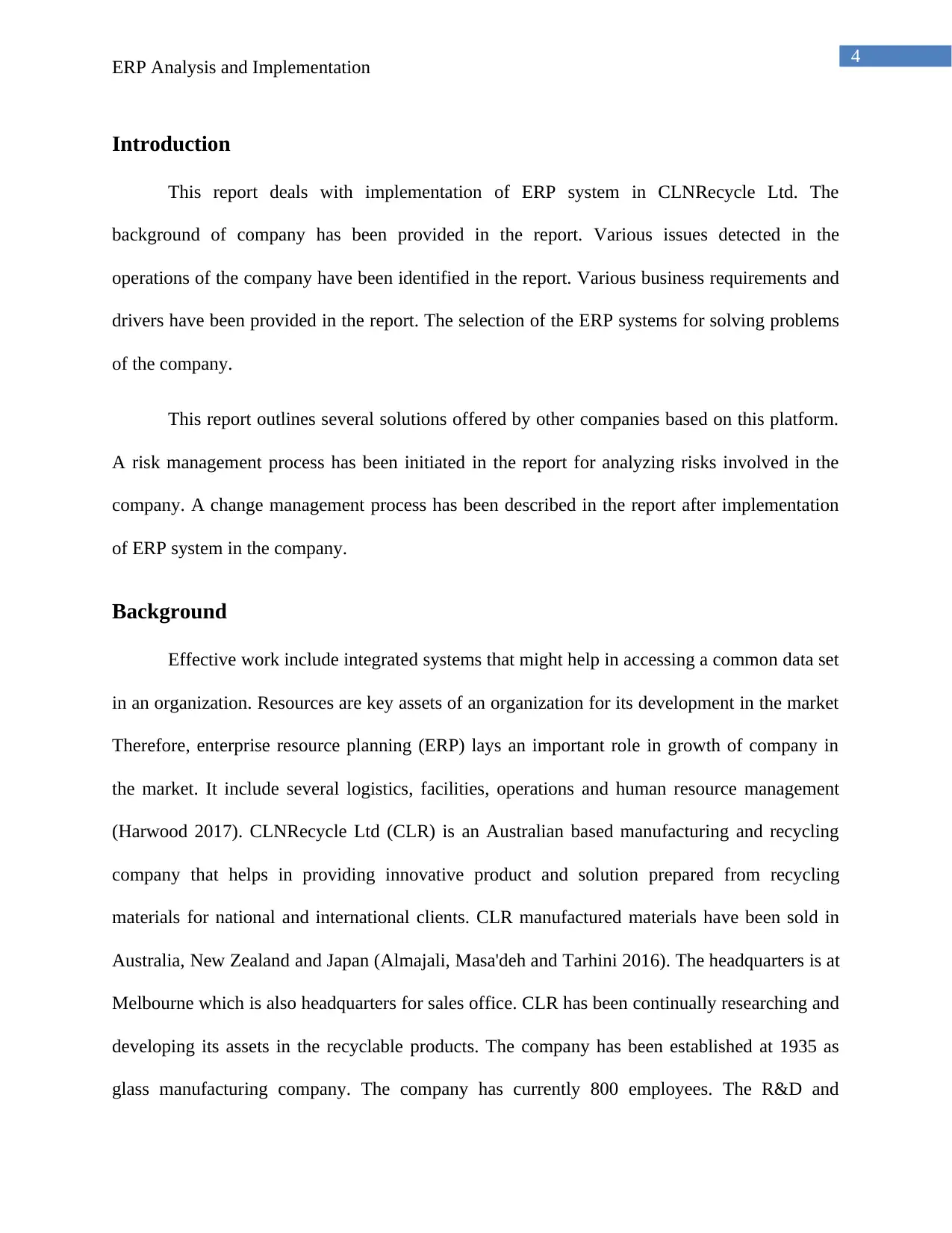
4
ERP Analysis and Implementation
Introduction
This report deals with implementation of ERP system in CLNRecycle Ltd. The
background of company has been provided in the report. Various issues detected in the
operations of the company have been identified in the report. Various business requirements and
drivers have been provided in the report. The selection of the ERP systems for solving problems
of the company.
This report outlines several solutions offered by other companies based on this platform.
A risk management process has been initiated in the report for analyzing risks involved in the
company. A change management process has been described in the report after implementation
of ERP system in the company.
Background
Effective work include integrated systems that might help in accessing a common data set
in an organization. Resources are key assets of an organization for its development in the market
Therefore, enterprise resource planning (ERP) lays an important role in growth of company in
the market. It include several logistics, facilities, operations and human resource management
(Harwood 2017). CLNRecycle Ltd (CLR) is an Australian based manufacturing and recycling
company that helps in providing innovative product and solution prepared from recycling
materials for national and international clients. CLR manufactured materials have been sold in
Australia, New Zealand and Japan (Almajali, Masa'deh and Tarhini 2016). The headquarters is at
Melbourne which is also headquarters for sales office. CLR has been continually researching and
developing its assets in the recyclable products. The company has been established at 1935 as
glass manufacturing company. The company has currently 800 employees. The R&D and
ERP Analysis and Implementation
Introduction
This report deals with implementation of ERP system in CLNRecycle Ltd. The
background of company has been provided in the report. Various issues detected in the
operations of the company have been identified in the report. Various business requirements and
drivers have been provided in the report. The selection of the ERP systems for solving problems
of the company.
This report outlines several solutions offered by other companies based on this platform.
A risk management process has been initiated in the report for analyzing risks involved in the
company. A change management process has been described in the report after implementation
of ERP system in the company.
Background
Effective work include integrated systems that might help in accessing a common data set
in an organization. Resources are key assets of an organization for its development in the market
Therefore, enterprise resource planning (ERP) lays an important role in growth of company in
the market. It include several logistics, facilities, operations and human resource management
(Harwood 2017). CLNRecycle Ltd (CLR) is an Australian based manufacturing and recycling
company that helps in providing innovative product and solution prepared from recycling
materials for national and international clients. CLR manufactured materials have been sold in
Australia, New Zealand and Japan (Almajali, Masa'deh and Tarhini 2016). The headquarters is at
Melbourne which is also headquarters for sales office. CLR has been continually researching and
developing its assets in the recyclable products. The company has been established at 1935 as
glass manufacturing company. The company has currently 800 employees. The R&D and
Paraphrase This Document
Need a fresh take? Get an instant paraphrase of this document with our AI Paraphraser

5
ERP Analysis and Implementation
Product Design units have been located in the Melbourne office that directly communicate with
the director of the company (Ram, Wu and Tagg 2014). The company has been operating with
traditional supply chain system focusing on local suppliers sand long0term contracts between
suppliers and company. Therefore, this have been creating challenges for the company in the
market.
Analysis and Evaluation
Analysis of current situation
There are various business requirements and drivers of CLR in the market. Some of these
are mentioned below:
Revenue and Market share: CLR have to focus on the market share for reducing costs in
competitive world. Revenue generation has been an important asset for the company in order to
develop in the market (Sun, Ni and Lam 2015). The strategic management of CLR have to
maintain a keen approach to development of company in the market. The use of product
platforms have been increasing complexity and costs.
Creating product features and performance: The cost of the raw materials for
manufacturing needs to be in control for providing maximum profit to the company. The change
in the manufacturing use of the CLR Company has been helping in maintaining a labelled
approach to the growth of the company.
Access engineering capability: Engineering in the product innovation has been an
important point of company. Product innovation has been helping in increasing the demand of
the product in the market.
ERP Analysis and Implementation
Product Design units have been located in the Melbourne office that directly communicate with
the director of the company (Ram, Wu and Tagg 2014). The company has been operating with
traditional supply chain system focusing on local suppliers sand long0term contracts between
suppliers and company. Therefore, this have been creating challenges for the company in the
market.
Analysis and Evaluation
Analysis of current situation
There are various business requirements and drivers of CLR in the market. Some of these
are mentioned below:
Revenue and Market share: CLR have to focus on the market share for reducing costs in
competitive world. Revenue generation has been an important asset for the company in order to
develop in the market (Sun, Ni and Lam 2015). The strategic management of CLR have to
maintain a keen approach to development of company in the market. The use of product
platforms have been increasing complexity and costs.
Creating product features and performance: The cost of the raw materials for
manufacturing needs to be in control for providing maximum profit to the company. The change
in the manufacturing use of the CLR Company has been helping in maintaining a labelled
approach to the growth of the company.
Access engineering capability: Engineering in the product innovation has been an
important point of company. Product innovation has been helping in increasing the demand of
the product in the market.
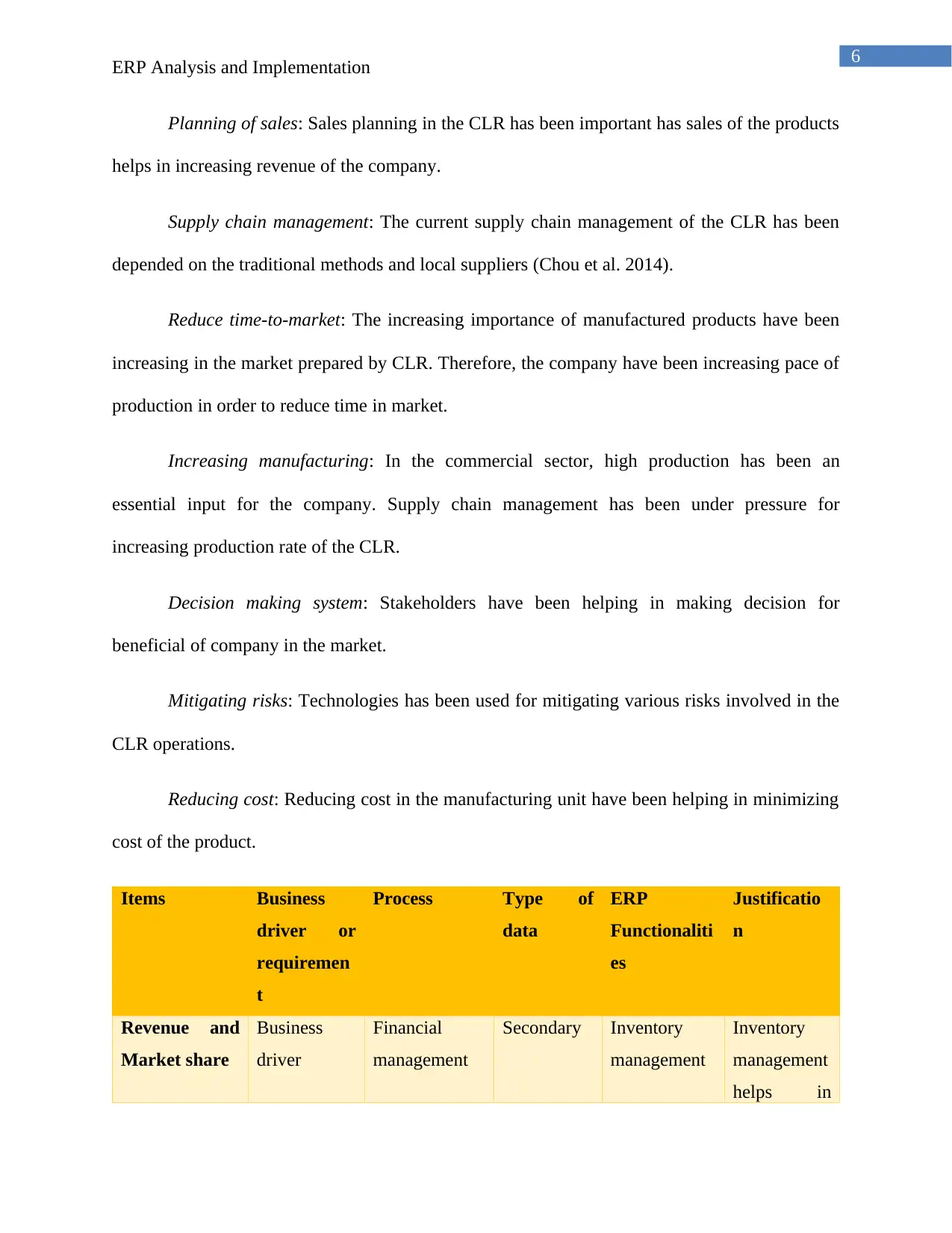
6
ERP Analysis and Implementation
Planning of sales: Sales planning in the CLR has been important has sales of the products
helps in increasing revenue of the company.
Supply chain management: The current supply chain management of the CLR has been
depended on the traditional methods and local suppliers (Chou et al. 2014).
Reduce time-to-market: The increasing importance of manufactured products have been
increasing in the market prepared by CLR. Therefore, the company have been increasing pace of
production in order to reduce time in market.
Increasing manufacturing: In the commercial sector, high production has been an
essential input for the company. Supply chain management has been under pressure for
increasing production rate of the CLR.
Decision making system: Stakeholders have been helping in making decision for
beneficial of company in the market.
Mitigating risks: Technologies has been used for mitigating various risks involved in the
CLR operations.
Reducing cost: Reducing cost in the manufacturing unit have been helping in minimizing
cost of the product.
Items Business
driver or
requiremen
t
Process Type of
data
ERP
Functionaliti
es
Justificatio
n
Revenue and
Market share
Business
driver
Financial
management
Secondary Inventory
management
Inventory
management
helps in
ERP Analysis and Implementation
Planning of sales: Sales planning in the CLR has been important has sales of the products
helps in increasing revenue of the company.
Supply chain management: The current supply chain management of the CLR has been
depended on the traditional methods and local suppliers (Chou et al. 2014).
Reduce time-to-market: The increasing importance of manufactured products have been
increasing in the market prepared by CLR. Therefore, the company have been increasing pace of
production in order to reduce time in market.
Increasing manufacturing: In the commercial sector, high production has been an
essential input for the company. Supply chain management has been under pressure for
increasing production rate of the CLR.
Decision making system: Stakeholders have been helping in making decision for
beneficial of company in the market.
Mitigating risks: Technologies has been used for mitigating various risks involved in the
CLR operations.
Reducing cost: Reducing cost in the manufacturing unit have been helping in minimizing
cost of the product.
Items Business
driver or
requiremen
t
Process Type of
data
ERP
Functionaliti
es
Justificatio
n
Revenue and
Market share
Business
driver
Financial
management
Secondary Inventory
management
Inventory
management
helps in
⊘ This is a preview!⊘
Do you want full access?
Subscribe today to unlock all pages.

Trusted by 1+ million students worldwide

7
ERP Analysis and Implementation
controlling
sticks and
revenue in
the market.
Creating
product
features and
performance
Business
requirement
Manufacturing Primary Manufacturin
g
Manufacturi
ng helps in
managing
products and
development
.
Access
engineering
capability
Business
driver
Operations Secondary Business
Intelligence
Business
intelligence
helps in
selecting
tools for
innovative
ideas and
technology.
Planning of
sales
Business
requirement
Administratio
n
Secondary Inventory
management
Inventory
management
helps in
providing
planning
sales of the
company.
Supply chain
management
Business
requirement
Sales and
Operation
planning
Primary Inventory
management
Inventory
management
helps in
managing
supply chain
system of
ERP Analysis and Implementation
controlling
sticks and
revenue in
the market.
Creating
product
features and
performance
Business
requirement
Manufacturing Primary Manufacturin
g
Manufacturi
ng helps in
managing
products and
development
.
Access
engineering
capability
Business
driver
Operations Secondary Business
Intelligence
Business
intelligence
helps in
selecting
tools for
innovative
ideas and
technology.
Planning of
sales
Business
requirement
Administratio
n
Secondary Inventory
management
Inventory
management
helps in
providing
planning
sales of the
company.
Supply chain
management
Business
requirement
Sales and
Operation
planning
Primary Inventory
management
Inventory
management
helps in
managing
supply chain
system of
Paraphrase This Document
Need a fresh take? Get an instant paraphrase of this document with our AI Paraphraser
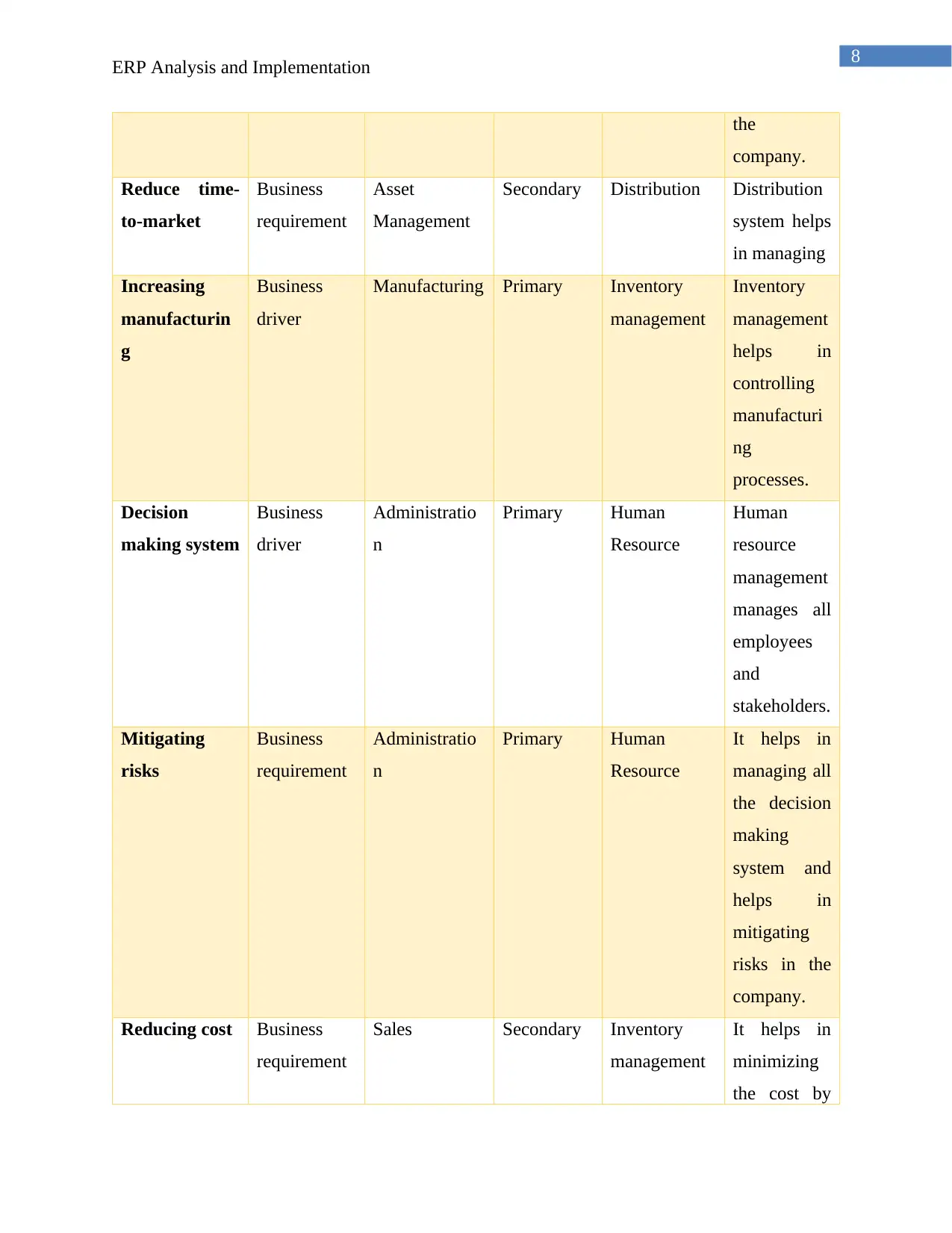
8
ERP Analysis and Implementation
the
company.
Reduce time-
to-market
Business
requirement
Asset
Management
Secondary Distribution Distribution
system helps
in managing
Increasing
manufacturin
g
Business
driver
Manufacturing Primary Inventory
management
Inventory
management
helps in
controlling
manufacturi
ng
processes.
Decision
making system
Business
driver
Administratio
n
Primary Human
Resource
Human
resource
management
manages all
employees
and
stakeholders.
Mitigating
risks
Business
requirement
Administratio
n
Primary Human
Resource
It helps in
managing all
the decision
making
system and
helps in
mitigating
risks in the
company.
Reducing cost Business
requirement
Sales Secondary Inventory
management
It helps in
minimizing
the cost by
ERP Analysis and Implementation
the
company.
Reduce time-
to-market
Business
requirement
Asset
Management
Secondary Distribution Distribution
system helps
in managing
Increasing
manufacturin
g
Business
driver
Manufacturing Primary Inventory
management
Inventory
management
helps in
controlling
manufacturi
ng
processes.
Decision
making system
Business
driver
Administratio
n
Primary Human
Resource
Human
resource
management
manages all
employees
and
stakeholders.
Mitigating
risks
Business
requirement
Administratio
n
Primary Human
Resource
It helps in
managing all
the decision
making
system and
helps in
mitigating
risks in the
company.
Reducing cost Business
requirement
Sales Secondary Inventory
management
It helps in
minimizing
the cost by
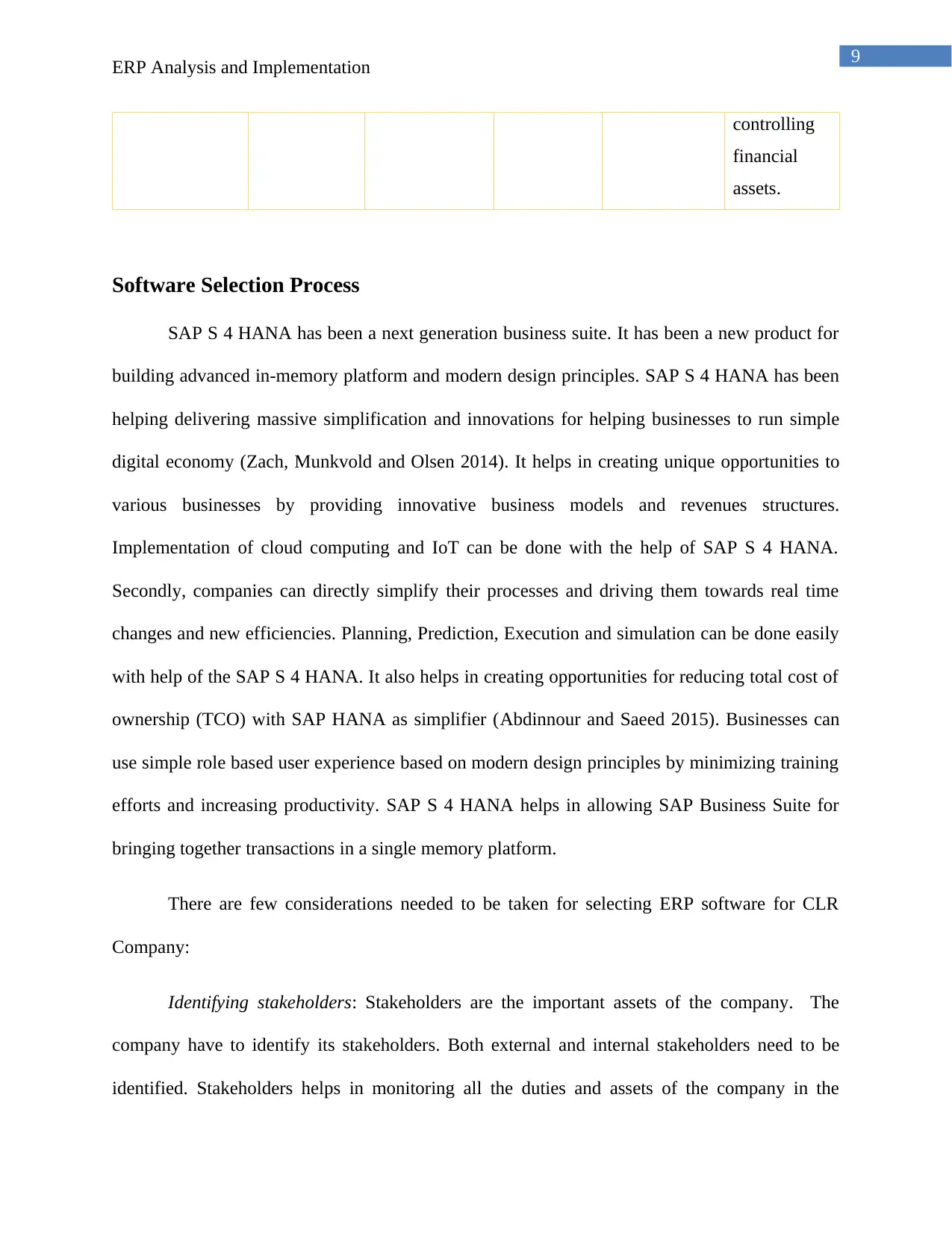
9
ERP Analysis and Implementation
controlling
financial
assets.
Software Selection Process
SAP S 4 HANA has been a next generation business suite. It has been a new product for
building advanced in-memory platform and modern design principles. SAP S 4 HANA has been
helping delivering massive simplification and innovations for helping businesses to run simple
digital economy (Zach, Munkvold and Olsen 2014). It helps in creating unique opportunities to
various businesses by providing innovative business models and revenues structures.
Implementation of cloud computing and IoT can be done with the help of SAP S 4 HANA.
Secondly, companies can directly simplify their processes and driving them towards real time
changes and new efficiencies. Planning, Prediction, Execution and simulation can be done easily
with help of the SAP S 4 HANA. It also helps in creating opportunities for reducing total cost of
ownership (TCO) with SAP HANA as simplifier (Abdinnour and Saeed 2015). Businesses can
use simple role based user experience based on modern design principles by minimizing training
efforts and increasing productivity. SAP S 4 HANA helps in allowing SAP Business Suite for
bringing together transactions in a single memory platform.
There are few considerations needed to be taken for selecting ERP software for CLR
Company:
Identifying stakeholders: Stakeholders are the important assets of the company. The
company have to identify its stakeholders. Both external and internal stakeholders need to be
identified. Stakeholders helps in monitoring all the duties and assets of the company in the
ERP Analysis and Implementation
controlling
financial
assets.
Software Selection Process
SAP S 4 HANA has been a next generation business suite. It has been a new product for
building advanced in-memory platform and modern design principles. SAP S 4 HANA has been
helping delivering massive simplification and innovations for helping businesses to run simple
digital economy (Zach, Munkvold and Olsen 2014). It helps in creating unique opportunities to
various businesses by providing innovative business models and revenues structures.
Implementation of cloud computing and IoT can be done with the help of SAP S 4 HANA.
Secondly, companies can directly simplify their processes and driving them towards real time
changes and new efficiencies. Planning, Prediction, Execution and simulation can be done easily
with help of the SAP S 4 HANA. It also helps in creating opportunities for reducing total cost of
ownership (TCO) with SAP HANA as simplifier (Abdinnour and Saeed 2015). Businesses can
use simple role based user experience based on modern design principles by minimizing training
efforts and increasing productivity. SAP S 4 HANA helps in allowing SAP Business Suite for
bringing together transactions in a single memory platform.
There are few considerations needed to be taken for selecting ERP software for CLR
Company:
Identifying stakeholders: Stakeholders are the important assets of the company. The
company have to identify its stakeholders. Both external and internal stakeholders need to be
identified. Stakeholders helps in monitoring all the duties and assets of the company in the
⊘ This is a preview!⊘
Do you want full access?
Subscribe today to unlock all pages.

Trusted by 1+ million students worldwide

10
ERP Analysis and Implementation
market. External stakeholders deals with external factors in the environment affecting growth of
the company in the market. Internal stakeholders are directly linked with the development of
company. The involvement of the stakeholders help in improving decision making system of the
company (Bintoro et al. 2015). The requirement of ERP software in the company need to be
analysed and decision has ti be made by the stakeholders.
Key business requirements: It has been necessary to identify key business requirements in
the company. Various researches are need to be done for identifying business requirements.
Various business requirements of CLR have been already identified in previous sections.
Strategic plan needs to be prepared for ensuring safe future of the company. Strategic plans help
in redefining objectives and goals of the company in the future.
Total Cost Ownership (TCO) for solution: Before signing with any ERP software
package, cost and budget of whole investment need to be calculated by the financial department
of the company. This might help in providing creative strategies for the implementation of the
ERP software (Liao, Huang and Lin 2018). All ongoing projects and pending projects need to be
analyzed as they have been already invested with high amount.
ERP Analysis and Implementation
market. External stakeholders deals with external factors in the environment affecting growth of
the company in the market. Internal stakeholders are directly linked with the development of
company. The involvement of the stakeholders help in improving decision making system of the
company (Bintoro et al. 2015). The requirement of ERP software in the company need to be
analysed and decision has ti be made by the stakeholders.
Key business requirements: It has been necessary to identify key business requirements in
the company. Various researches are need to be done for identifying business requirements.
Various business requirements of CLR have been already identified in previous sections.
Strategic plan needs to be prepared for ensuring safe future of the company. Strategic plans help
in redefining objectives and goals of the company in the future.
Total Cost Ownership (TCO) for solution: Before signing with any ERP software
package, cost and budget of whole investment need to be calculated by the financial department
of the company. This might help in providing creative strategies for the implementation of the
ERP software (Liao, Huang and Lin 2018). All ongoing projects and pending projects need to be
analyzed as they have been already invested with high amount.
Paraphrase This Document
Need a fresh take? Get an instant paraphrase of this document with our AI Paraphraser

11
ERP Analysis and Implementation
Figure 1: Rich Picture
(Source: Created by Author)
SAP ECC6 helps in providing flexibility for creating own SAP structure for the company.
SAP manages various supply chain, financial transactions, activities and product life cycles. The
use of various analytical features, evaluating performance and decision making system. SAP
helps in analyzing data and information from any source related to the business operations (Abu-
Shanab, Abu-Shehab and Khairallah 2015). These features have been net by using the SAP
ECC6 software in nay business organization. However, SAP ECC6 has been a costly product for
any small and medium sized enterprise. Therefore, most of the companies are not able to
implement SAP in their operations.
In the case of CLR Company, SAP ECC6 can be used in the company for mitigating
issues related to their operations in the market. This software helps in managing all the financial
transaction, operations and decision making system. The use of SAP ECC6 will be beneficial for
the company as it help in setting parameters for development of company in market. This
software helps in providing a keen approach to the growth of the financial and revenue of the
company in the market. It also helps in enabling various business processes for managing
different aspects of the business in the market (Bernroider, Wong and Lai 2014). SAP helps in
tracking financial accounting of the company. Therefore, CLR might select SAP ECC6 software
for the development of company in market.
The implementation of ERP system in CLR can be initialized by using te Big Bang
approach. The big bang approach of ERP implementation always occurs in single major event.
There have been various pre-implementation planning for the implementation of ERP system.
ERP Analysis and Implementation
Figure 1: Rich Picture
(Source: Created by Author)
SAP ECC6 helps in providing flexibility for creating own SAP structure for the company.
SAP manages various supply chain, financial transactions, activities and product life cycles. The
use of various analytical features, evaluating performance and decision making system. SAP
helps in analyzing data and information from any source related to the business operations (Abu-
Shanab, Abu-Shehab and Khairallah 2015). These features have been net by using the SAP
ECC6 software in nay business organization. However, SAP ECC6 has been a costly product for
any small and medium sized enterprise. Therefore, most of the companies are not able to
implement SAP in their operations.
In the case of CLR Company, SAP ECC6 can be used in the company for mitigating
issues related to their operations in the market. This software helps in managing all the financial
transaction, operations and decision making system. The use of SAP ECC6 will be beneficial for
the company as it help in setting parameters for development of company in market. This
software helps in providing a keen approach to the growth of the financial and revenue of the
company in the market. It also helps in enabling various business processes for managing
different aspects of the business in the market (Bernroider, Wong and Lai 2014). SAP helps in
tracking financial accounting of the company. Therefore, CLR might select SAP ECC6 software
for the development of company in market.
The implementation of ERP system in CLR can be initialized by using te Big Bang
approach. The big bang approach of ERP implementation always occurs in single major event.
There have been various pre-implementation planning for the implementation of ERP system.
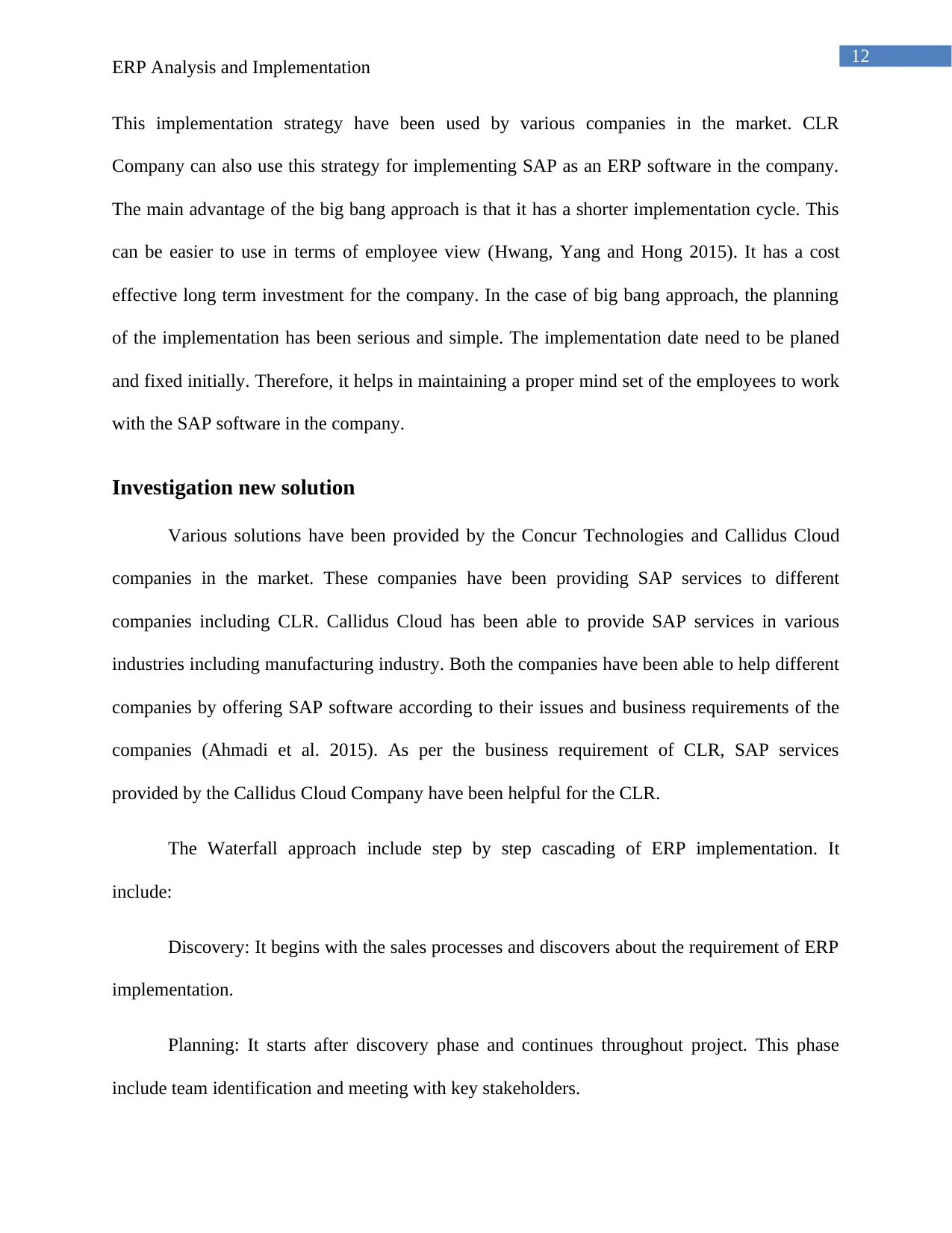
12
ERP Analysis and Implementation
This implementation strategy have been used by various companies in the market. CLR
Company can also use this strategy for implementing SAP as an ERP software in the company.
The main advantage of the big bang approach is that it has a shorter implementation cycle. This
can be easier to use in terms of employee view (Hwang, Yang and Hong 2015). It has a cost
effective long term investment for the company. In the case of big bang approach, the planning
of the implementation has been serious and simple. The implementation date need to be planed
and fixed initially. Therefore, it helps in maintaining a proper mind set of the employees to work
with the SAP software in the company.
Investigation new solution
Various solutions have been provided by the Concur Technologies and Callidus Cloud
companies in the market. These companies have been providing SAP services to different
companies including CLR. Callidus Cloud has been able to provide SAP services in various
industries including manufacturing industry. Both the companies have been able to help different
companies by offering SAP software according to their issues and business requirements of the
companies (Ahmadi et al. 2015). As per the business requirement of CLR, SAP services
provided by the Callidus Cloud Company have been helpful for the CLR.
The Waterfall approach include step by step cascading of ERP implementation. It
include:
Discovery: It begins with the sales processes and discovers about the requirement of ERP
implementation.
Planning: It starts after discovery phase and continues throughout project. This phase
include team identification and meeting with key stakeholders.
ERP Analysis and Implementation
This implementation strategy have been used by various companies in the market. CLR
Company can also use this strategy for implementing SAP as an ERP software in the company.
The main advantage of the big bang approach is that it has a shorter implementation cycle. This
can be easier to use in terms of employee view (Hwang, Yang and Hong 2015). It has a cost
effective long term investment for the company. In the case of big bang approach, the planning
of the implementation has been serious and simple. The implementation date need to be planed
and fixed initially. Therefore, it helps in maintaining a proper mind set of the employees to work
with the SAP software in the company.
Investigation new solution
Various solutions have been provided by the Concur Technologies and Callidus Cloud
companies in the market. These companies have been providing SAP services to different
companies including CLR. Callidus Cloud has been able to provide SAP services in various
industries including manufacturing industry. Both the companies have been able to help different
companies by offering SAP software according to their issues and business requirements of the
companies (Ahmadi et al. 2015). As per the business requirement of CLR, SAP services
provided by the Callidus Cloud Company have been helpful for the CLR.
The Waterfall approach include step by step cascading of ERP implementation. It
include:
Discovery: It begins with the sales processes and discovers about the requirement of ERP
implementation.
Planning: It starts after discovery phase and continues throughout project. This phase
include team identification and meeting with key stakeholders.
⊘ This is a preview!⊘
Do you want full access?
Subscribe today to unlock all pages.

Trusted by 1+ million students worldwide
1 out of 22
Related Documents
Your All-in-One AI-Powered Toolkit for Academic Success.
+13062052269
info@desklib.com
Available 24*7 on WhatsApp / Email
![[object Object]](/_next/static/media/star-bottom.7253800d.svg)
Unlock your academic potential
Copyright © 2020–2025 A2Z Services. All Rights Reserved. Developed and managed by ZUCOL.





